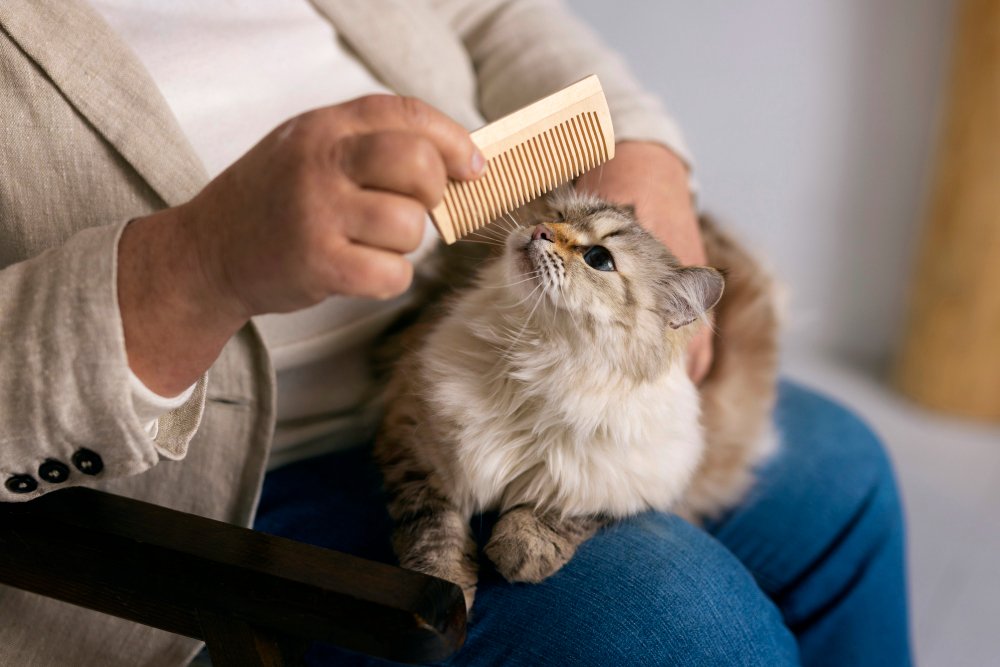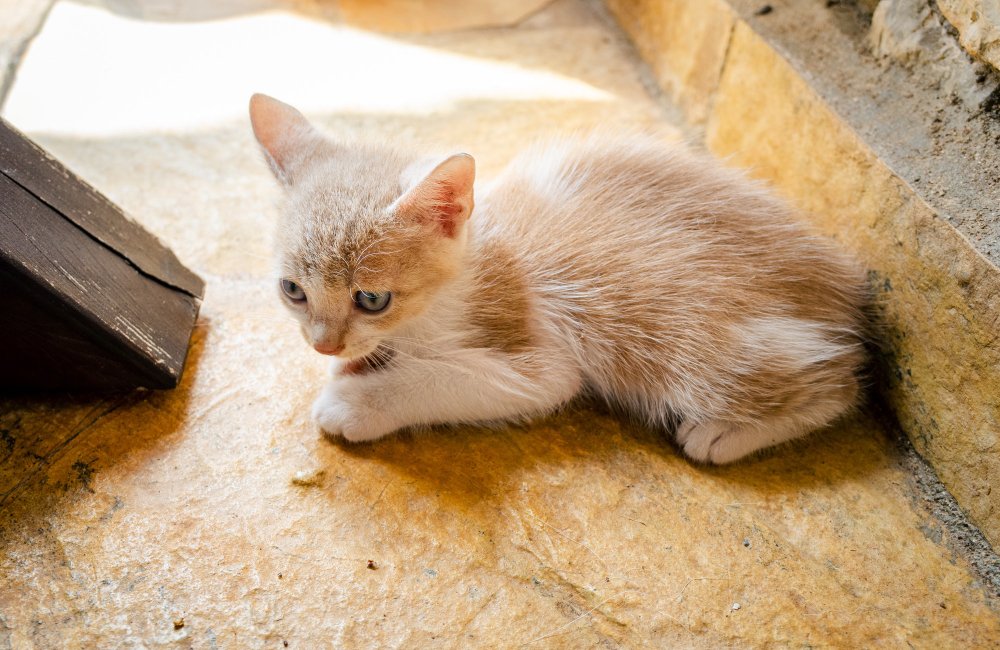Top 6 Natural Ways to Reduce Cat Shedding at Home
If you’re a cat parent, you’ve probably found yourself vacuuming up fur from your couch, lint-rolling your favorite sweater, or fishing cat hair out of your coffee cup. Shedding is just part of life with a furry feline, but when it feels like your home is turning into a fur factory, it’s time to take action! At Petzooie, we get how frustrating it can be to manage all that fluff, especially if you’ve got a long-haired kitty like a Persian or Maine Coon. The good news? You can cut down on shedding with simple, natural methods that keep your cat healthy and your home cleaner. With insights from vets and pet experts, here are our top six natural ways to reduce cat shedding at home—because less fur means more snuggle time!
Table of Contents
-
Why Does My Cat Shed So Much?
-
Top 6 Natural Ways to Reduce Cat Shedding
-
1. Brush Like You Mean It
-
2. Feed Them the Good Stuff
-
3. Keep Them Hydrated
-
4. Chill Out the Stress
-
5. Boost with Omega Supplements
-
6. Create a Fur-Friendly Zone
-
-
When to Call the Vet
-
Keeping Shedding in Check Long-Term
-
Conclusion: A Happier, Less Hairy Home
Why Does My Cat Shed So Much?

Before we dive into solutions, let’s talk about why your cat is leaving a trail of fur everywhere. Shedding is totally normal—it’s how cats replace old or damaged hair with fresh strands. Dr. Michelle Dulake, a veterinarian with years of experience, explains that cats shed year-round, with bigger bursts in spring and fall to prep for seasonal coat changes. Indoor cats, like your pampered house panther, might shed steadily because they’re not exposed to outdoor temperature shifts. A 2024 Cats.com article points out that long-haired breeds, like Ragdolls, shed more than short-haired ones, like Abyssinians, while hairless breeds like Sphynx barely shed at all.
But if your cat’s shedding seems out of control, there could be more to it. Poor diet, stress, or even health issues like allergies or parasites can crank up the fur-flying. Here are some common culprits:
-
Diet Gaps: Low-quality food missing key nutrients like protein or fatty acids can lead to a dull, shedding-prone coat.
-
Stress Vibes: Moving, new pets, or loud noises can stress your cat, triggering extra shedding.
-
Health Concerns: Skin infections, fleas, or hormonal issues might cause abnormal hair loss.
-
Grooming Struggles: Older or chubby cats may not groom as well, leaving loose fur to scatter.
If you’re seeing bald spots, red skin, or sudden shedding spikes, don’t wait—check in with your vet to rule out medical issues. Otherwise, these natural tips can help keep shedding in check.
Curious about spotting health issues early? Check out our cat health basics guide.
Top 6 Natural Ways to Reduce Cat Shedding

Ready to tame the tumbleweeds of cat fur? These vet-approved, natural methods are easy to try at home and will help your cat’s coat stay sleek and healthy. Always chat with your vet before making big changes, especially with diet or supplements.
1. Brush Like You Mean It
Nothing beats a good brushing session for cutting down on shedding. It’s like giving your cat a spa day while saving your furniture! Brushing sweeps up loose hair, spreads natural oils for a shiny coat, and prevents those pesky hairballs. A 2022 Bond Vet article swears by daily brushing to trap fur before it lands on your couch.
-
How to Do It: Grab a de-shedding tool like the Furminator for long-haired cats or a grooming glove for short-haired ones. Spend 5-10 minutes brushing daily, using treats to make it fun. For long-haired breeds, a slicker brush works wonders on mats.
-
Pro Tip: Start young to get your cat comfy with brushing. If they’re fussy, go slow and use a soft brush to avoid irritating their skin.
-
Who It’s For: Every cat, especially fluffballs like Persians or Siberians.
2. Feed Them the Good Stuff
What your cat eats shows up in their coat. A diet packed with high-quality protein and essential fatty acids can work wonders for reducing shedding. Dr. Jennifer Coates, writing for PetMD in 2014, says foods with 45% protein and 25-35% fat (think omega-3 and omega-6) strengthen hair follicles, keeping fur firmly in place.
-
How to Do It: Pick AAFCO-approved cat food with real meat (like chicken or salmon) listed first. Wet food adds moisture, which is great for skin health. Steer clear of cheap fillers like corn or soy that can dull your cat’s coat.
-
Pro Tip: Transition to new food slowly over 7-10 days to avoid tummy troubles. Ask your vet for breed-specific recommendations.
-
Who It’s For: Cats with brittle or lackluster coats.
3. Keep Them Hydrated
Dry skin means more shedding, and hydration is key to a healthy coat. A 2023 Uproot Clean article points out that dehydrated cats can have flaky, shedding-prone skin, especially in dry climates or winter months.
-
How to Do It: Set out clean, fresh water in multiple spots around your home, ideally in a pet fountain—cats love running water! Adding wet food (70-80% moisture) to their diet also boosts hydration.
-
Pro Tip: Clean water bowls daily to keep bacteria at bay, and try stainless steel or ceramic bowls to avoid plastic allergies.
-
Who It’s For: Indoor cats or those with dry, flaky skin.
4. Chill Out the Stress
Stress can turn your cat into a shedding machine. Whether it’s a new pet, a move, or construction noise, anxiety can make fur fly. A 2024 Cats.com article notes that calming aids can help reduce stress-related shedding.
-
How to Do It: Plug a Feliway pheromone diffuser into your cat’s favorite hangout spot to create a calming atmosphere. Offer safe spaces like a cozy cat tree or a quiet nook with a blanket. Stick to a predictable routine for feeding and playtime.
-
Pro Tip: Sprinkle catnip on a scratching post or play with a feather wand to burn off nervous energy and keep your cat relaxed.
-
Who It’s For: Anxious kitties or those adjusting to household changes.
5. Boost with Omega Supplements
Omega-3 and omega-6 fatty acids are like superfoods for your cat’s coat, strengthening hair follicles and reducing inflammation. According to a 2020 BetterWithCats article citing Purina, omega supplements can help reduce shedding by improving overall skin health.
-
How to Do It: Add a vet-approved fish oil supplement, like Nordic Naturals Omega-3 Pet, to your cat’s food. For a 10-pound cat, aim for 100-200 mg of EPA/DHA daily, but check with your vet for exact dosing.
-
Pro Tip: Start with a small dose to avoid tummy upset, and store fish oil in the fridge to keep it fresh.
-
Who It’s For: Cats with dry coats or mild allergies.
6. Create a Fur-Friendly Zone
Want to keep fur off your couch? Give your cat a designated spot where shedding is welcome. A 2023 All About Cats article suggests that a cozy bed or cat tower can act like a fur magnet, making cleanup a breeze.
-
How to Do It: Set up a washable cat bed or a cat tower in a quiet corner. Spritz it with catnip spray to lure your cat over. Vacuum or lint-roll the area weekly to manage collected fur.
-
Pro Tip: Use a machine-washable cover on the bed for easy maintenance, and reward your cat with treats for using it.
-
Who It’s For: Homes drowning in cat hair on furniture.
When to Call the Vet

These natural methods work great for normal shedding, but if your cat’s losing clumps of fur or showing other red flags, it’s time for a vet visit. A 2024 Joii Pet Care article warns that excessive shedding can signal health issues like:
-
Bald patches or thinning fur.
-
Red, irritated skin or scabs.
-
Scratching more than usual or acting lethargic.
-
Sudden shedding spikes are not tied to seasonal changes.
Your veterinarian may run tests such as skin scrapings or blood work to check for parasites, allergies, or hormonal imbalances. Don’t delay—early action can prevent bigger problems.
Keeping Shedding in Check Long-Term
To stay ahead of shedding:
-
Groom Consistently: Brush short-haired cats weekly, long-haired ones daily.
-
Stick to Quality Food: Avoid sudden diet switches to maintain coat health.
-
Flea Prevention: Use vet-approved treatments like Revolution to keep parasites away.
-
Regular Checkups: Annual vet visits catch issues before they lead to shedding spikes.
Dive into our cat grooming guide for more coat-care tips.
Conclusion: A Happier, Less Hairy Home
Dealing with cat shedding doesn’t have to feel like a full-time job. With these six natural tricks—brushing, better food, hydration, stress relief, omega supplements, and a fur-friendly zone—you can cut down on fur tumbleweeds and keep your cat’s coat gleaming. At Petzooie, we’re all about making life with your kitty easier and more fun. Try these tips, and if shedding seems out of control, give your vet a call to keep your feline friend in top shape.
Got a shedding solution that works for your cat? Subscribe to Petzooie’s newsletter for the latest scoop on keeping your cat healthy and your home fur-free.



.jpg)



